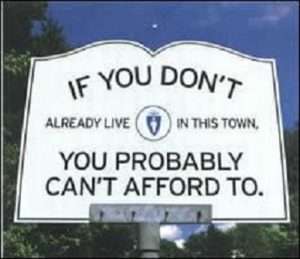The Volokh Conspiracy
Mostly law professors | Sometimes contrarian | Often libertarian | Always independent
Exclusionary Zoning is Even Worse than Previously Thought
Fixing a calculation error in a leading academic article on the subject shows that zoning has a far bigger negative impact on the economy than was previously realized.

Economists and land-use scholars across the political spectrum have long known that restrictive zoning cuts off millions of people from housing and job opportunities. It is one of the biggest obstacles to increasing economic growth and promoting opportunity for the poor and disadvantaged. But new evidence suggests that the problem is even worse than previously thought.
The work of economists Chang-Tai Hsieh and Enrico Moretti is perhaps the most influential in the literature documenting the impact of zoning on economic growth. Recently, my George Mason University colleague, economist Bryan Caplan, discovered some significant calculation errors in their pathbreaking 2019 article "Housing Constraints and Spatial Misallocation." Hsieh and Moretti have graciously acknowledged the mistake.
When scholars err, the effect is often to make their arguments seem stronger or better-supported than is actually the case. In this instance, however, Hsieh and Moretti's mistake actually made the harmful effects of zoning seem much smaller than is actually the case. Bryan explains:
Where did HM go wrong? On pp.25-6 of their article, they write:
Starting with perfect mobility, the second row in Table 4 shows the effect of changing the housing supply regulation only in New York, San Jose, and San Francisco to that in the median US city. This would increase the growth rate of aggregate output from 0.795 percent to 1.49 percent per year—an 87 percent increase (column 1). The net effect is that US GDP in 2009 would be 8.9 percent higher under this counterfactual, which translates into an additional $8,775 in average wages for all workers.
On the next page, they re-estimate the results with imperfect mobility:
Table 5 shows that changing the housing supply regulation in New York, San Jose, and San Francisco to that in the median US city would increase the growth rate of aggregate output by 36.3 percent (second row). The net effect is that US GDP in 2009 would be 3.7 percent higher under this counterfactual, which translates into an additional $3,685 in average wages for all workers, or an increase of $0.53 trillion in the wage bill.
Both tables indicate that HM are covering the period from 1964-2009. How then can these enormous changes in the annual growth rate, compounded over 45 years, lead to relatively modest changes in total GDP? Answer: They can't!
The correct estimate to derive from Table 4 is that GDP will be 1.0149^45/1.00795^45=+36% higher, not +8.9%.
Similarly, the correct estimate to derive from Table 5 is that growth will be 1.084% per year (.795%*1.363), so GDP will be 1.0108^45/1.00795=+14% higher, not +3.7%.
Bryan also describes some similar mistakes elsewhere in the article.
The upshot of all of them is that restrictive zoning reduces GDP several times more than Hsieh and Moretti's original calculations imply. And, I would add that a high percentage of that loss falls on the poor and disadvantaged (who are, for obvious reasons, disproportionately represented among those priced out of desirable housing markets and the jobs available there, as a result of artificial supply constraints imposed by zoning).
I cite some of the earlier Hsieh-Moretti estimates in my own work, including Chapter 2 of my book Free to Move: Foot Voting, Migration, and Political Freedom. I plan to update as as soon as I get the chance!
All of us who work on these issues owe a debt to Bryan Caplan for discovering this problem in the data, and bringing it to our attention. At least in the United States, exclusionary zoning is the biggest property rights issue of our time. It severely constricts the rights of millions of property owners. It is also one of the biggest obstacles to increasing economic growth and alleviating poverty.
Bryan's discovery shows the latter aspect of the issue is even worse than we thought. He is now working on a book about housing and zoning, which I look forward to with great interest.
In recent years, there has been important progress on reducing zoning in several parts of the country. The Biden administration has included some useful incentives for state and local governments to cut back on zoning in its otherwise mostly awful infrastructure bill. But much, much more needs to be done.


Show Comments (108)